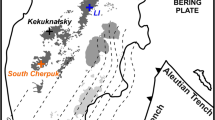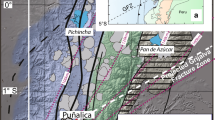Abstract.
Geochemical data from melt inclusions in olivine phenocrysts in a picritic basalt from the Siqueiros Transform Fault on the northern East Pacific Rise provide insights into the petrogenesis of mid-ocean ridge basalts (MORB). The fresh lava contains ~10% of olivine phenocrysts (Fo89.3–91.2) and rare, small (<1 mm) plagioclase phenocrysts with subhedral to irregular shapes with a range of compositions (An80–90, An57–63). Melt inclusions in olivine phenocrysts are glassy, generally rounded in shape and vary in size from a few to ~200 µm. Although most of the inclusions have compositions that are generally consistent with being representative of parental melts for the pillow-rim glasses, several inclusions are clearly different. One inclusion, which contains a euhedral grain of high-Al, low-Ti spinel, has a composition unlike any melt inclusions previously described from primitive phenocrysts in MORB. It has a very high Al2O3 (~20 wt%), very low TiO2 (~0.04 wt%) and Na2O (~1 wt%) contents, and a very high CaO/Na2O value (~14). The glass inclusion is strongly depleted in all incompatible elements (La =0.052 ppm; Yb =0.34; La/Sm(n) ~0.27), but it has large positive Sr and Eu anomalies (Sr/Sr* ~30; Eu/Eu* ~3) and a negative Zr anomaly. It also has low S (0.015 wt%) and relatively high Cl (180 ppm). We suggest that this unusual composition is a consequence of olivine trapping plagioclase in a hot, strongly plagioclase-undersaturated magma and subsequent reaction between plagioclase and the host olivine producing melt and residual spinel. Two other melt inclusions in a different olivine phenocryst have compositions that are generally intermediate between 'normal' inclusions and the aluminous inclusion, but have even higher CaO and Sr contents. They are also depleted in incompatible elements, but to a lesser degree than the aluminous inclusion, and have smaller Sr and Eu anomalies. Similar inclusions have also been described in high-Fo olivine phenocrysts from Iceland and northern Mid-Atlantic Ridge. We suggest that the compositions of these inclusions represent assimilation of gabbroic material into the hot primitive magma. The localised nature of this assimilation is consistent with it occurring within a crystal mush zone where the porosity is high as primitive magmas pass through earlier formed gabbroic 'cumulates'. In such an environment the contaminants are expected to have quite diverse compositions. Although the interaction of primitive melts with gabbroic material may not affect the compositions of erupted MORB melts on a large scale, this process may be important in some MORB suites and should be accounted for in petrogenetic models. Another important implication is that the observed variability in melt inclusion compositions in primitive MORB phenocrysts need not always to reflect processes occurring in the mantle. In particular, inferences on fractional melting processes based on geochemistry of ultra-depleted melt inclusions may not always be valid.
Similar content being viewed by others
Author information
Authors and Affiliations
Additional information
Electronic Publication
Rights and permissions
About this article
Cite this article
Danyushevsky, L.V., Perfit, M.R., Eggins, S.M. et al. Crustal origin for coupled 'ultra-depleted' and 'plagioclase' signatures in MORB olivine-hosted melt inclusions: evidence from the Siqueiros Transform Fault, East Pacific Rise. Contrib Mineral Petrol 144, 619–637 (2003). https://doi.org/10.1007/s00410-002-0420-3
Received:
Accepted:
Issue Date:
DOI: https://doi.org/10.1007/s00410-002-0420-3




